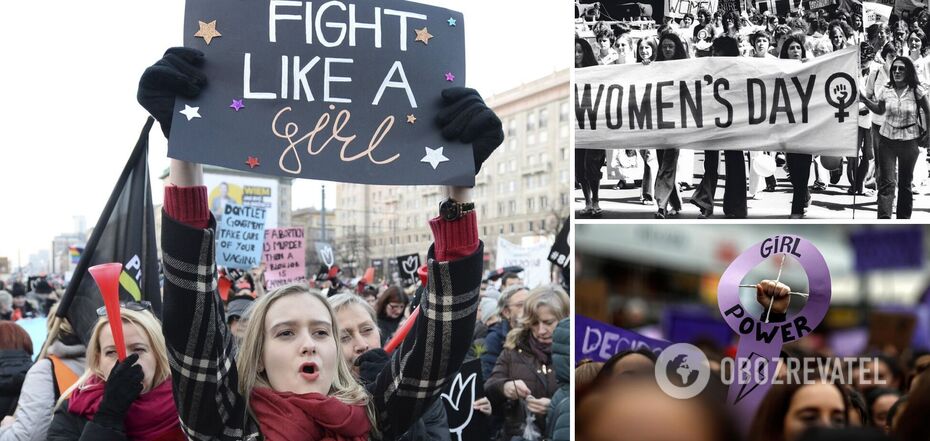Life
Why there was controversy over March 8: history and stereotypes around the holiday
In recent days, the debate over whether or not to celebrate March 8 has resumed with renewed vigour in Ukraine. Some say that it is a Soviet holiday that should be "decommunised", while others say that it is an internationally recognised day of women's solidarity that predates the USSR.
OBOZREVATEL found out more about March 8 and tells you where it came from and what stereotypes exist around it today. We also look at how other countries celebrate this date.
How the 8th of March came about
There were several reasons for choosing this date to celebrate International Women's Day. In 1857, American textile workers rallied in New York to demand equal pay for their work with men. Their demonstration was broken up by the police.
More than half a century later, in 1908, again in New York, women chose the same date to declare their desire to have the right to vote. They came out on March 8 to show their connection to the struggle for rights with the textile workers. This time, women also sought to improve their working conditions and ban child labour.
Almost a year later, in 1909, the Socialist Party of America proclaimed the first ever International Women's Day. It was February 28. That year and the next, party activists organised marches and strikes by women.
Already in 1910, European socialists decided to adopt the experience of their American colleagues. At a conference of the Socialist International in Copenhagen, German activist Clara Zetkin proposed that March 8 should be made the International Day for Women's Equality and Emancipation. A resolution was passed, but no dates have been set for the holiday.
The first day dedicated to women's rights was held on March 19, 1911, in Germany. The protesters demanded that women be given the right to vote and work, be given the opportunity to hold public office, and end discrimination in the workplace. In the same year, but on different days, mass actions took place in Austria-Hungary, Switzerland, and Denmark. With the outbreak of the First World War, the women's movement united with the peace movement.
The first coordinated celebration of Women's Day on March 8 took place in 1914. It was joined by the Austro-Hungarian Empire, Denmark, the German Empire, the Netherlands, Switzerland, and the Russian Empire. However, the date was not widely celebrated at the time. Feminists gave a new impetus to its spread in the 1960s and 1970s. They demanded the comprehensive liberation of women and the granting of equal rights to women and men in everything.
The United Nations recognised March 8 as a holiday in 1977, declaring it the Day for the Struggle for Women's Rights and International Peace. Under the auspices of the organisation, a new theme is chosen every year. This year, it will be unequal access to the internet and digital technologies.
How March 8 was treated in the USSR
In the early stages of the state's existence, Russian communists did indeed follow a feminist agenda and proclaimed emancipation. For example, they set up infrastructure for women to go to work early after childbirth, and gave women greater rights and freedoms. At that time, women workers held demonstrations on 8 March, and the holiday itself was perceived as a day of "female socialism builders". It was even called the International Women's Day.
March 8 became an official holiday in the USSR in 1921 on the initiative of the revolutionary Alexandra Kollontai. Her idea was supported by Vladimir Lenin. However, under the guise of fighting for women's rights, the councils, on the contrary, burdened their citizens even more, forcing them to combine work and motherhood without the possibility of counting on significant support.
However, in the first years of the holiday's existence, propaganda began to change narratives and shifted the focus towards glorifying motherhood and reinforcing patriarchal views of the family. This movement intensified after the mass repressions and the Second World War, when the state demanded that citizens increase their birth rate. At the same time, March 8 became a holiday mirroring February 23, the Defender of the Fatherland Day. They consistently honoured traditional masculinity and traditional femininity. Since 1965, 8 March has been a day off in the USSR. The tradition of celebrating this day the day before in work collectives and giving gifts to women, congratulating them for being "beautiful and tender" and praising childbearing as an end in itself, became widespread.
How March 8 is celebrated around the world
Despite the fact that many in Ukraine consider International Women's Day to be a Soviet relic, it has recently begun to gain more and more popularity around the world. For example, in the US, the entire month of March is dedicated to the history of the women's movement, and the president delivers a speech in honour of the achievements of the country's women. On 8 March, marches for women's rights are organised around the world, and many educational events are held. The official colour of the holiday is purple. In general, Mother's Day is a more popular "women's" holiday in the world.
Meanwhile, in communist China, on March 8, the government decided to make a shorter working day for women. But since the recommendation of the State Council of the People's Republic of China is not legally binding, employers often ignore it.
Earlier, OBOZREVATEL reported on the results of a survey of Ukrainians on whether March 8 should be a day off.
Subscribe to OBOZREVATEL's Telegram and Viber channels to keep up with the latest news.



























